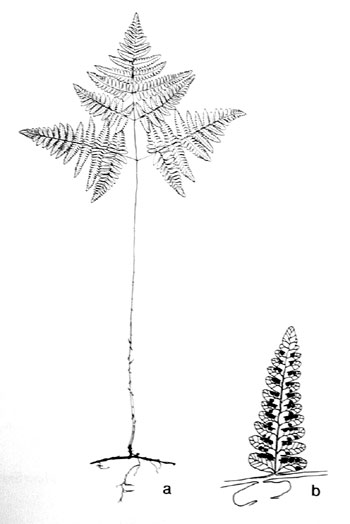|
Hardy Fern Home G. dryopteris resources
All Ferns � Woodsiaceae �� Gymnocarpium
�Other Genera
|
| Gymnocarpium dryopteris | ||
Oak fern | ||
|
Etymology
Greek: drys, oak + pteron, a wing, which describes the shape of the pinnae, but the word pteris was used by the ancient Greeks for all ferns.
Description
Rhizome: long-creeping, dark brown, forking.
Frond: 40 cm high by 15 cm wide, deciduous, monomorphic, blade/stipe ratio: 2:1 to 3:1. Stipe: grooved, straw-colored, darker, purplish at the base, scaly at base, vascular bundles: 2, oblong at stipe base, becoming round above. Blade: 2-pinnate pinnatifid, triangular to pentagonal, herbaceous, vivid green, only a few glands below. Pinnae: 6 to 10 pair, the lowest pair, exactly opposite, attached at a swollen junction, each similar to the remainder of the blade, only slightly smaller; pinnules the lower, basal pinnule of the basal pinna, most divided; costae grooved above, continuous from rachis to costae; margins entire to crenate; veins free, simple or forked. Sori: round, in rows near the margin, often merging at maturity, indusium: absent, sporangia: brownish, maturity: midsummer. Dimensionality: blade displayed horizontally. Culture
Habitat: acidic woodland.
Distribution: cicumboreal.
Hardy to -40�C, USDA Zone 2, requires a cool summer.
Distinctive Characteristics
horizontally held blade, a stand "a waving leaf blanket ... floating 10-20 cm above the ground," �llgaard, Scandinavian Ferns.
Synonyms
Polypodium dryopteris L. Dryopteris linnaeana C. Chr Curranina dryopteris (L.) Wherry Lastrea dryopteris (L.) Bory Phegopteris dryopteris (L.) Fee Thelypteris dryopteris (L.) Slosson Aspidium dryopteris Baumg. Carpogymnia dryopteris (L.) A. L�ve & D. L�ve Cystopteris dryopteris (L.) A. & D. L�ve Filix pumila Gilib. Nephrodium dryopteris (L.) Michx. Polystichum dryopteris (L.) Roth |
|
|
Notes
Compare to the similarity of each of the lowest pinnae to the upper, remainder of the blade separate this from G. robertianum.
Compare to the similarity of each of the lowest pinnae to the upper, remainder of the blade separate this from G. robertianum.

Gymnocarpium dryopteris. Two slightly oblong vascular bundles at stipe base, becoming round above. �Drawing from Ferns of Northeastern United States, Farida A. Wiley, 1936. |

Gymnocarpium dryopteris. Habitat: Hammel, Jutland, Denmark, early May with Oxalis acetosella. �Illustration from Scandinavian Ferns by Benjamin �llgaard and Kirsten Tind, Rhodos, 1993. |

Gymnocarpium dryopteris. The junction at the top of the stipe with the lowest pinnae pair is swollen. �Illustration from Scandinavian Ferns by Benjamin �llgaard and Kirsten Tind, Rhodos, 1993. |

Gymnocarpium dryopteris. a) frond, blade not extended vertically as shown, but horizontal; b) pinnule. �Illustration by V. Fulford from Ferns and Fern Allies of Canada, William J. Cody and Donald M. Britton, 1989, � Agriculture Canada, used with permission. |
